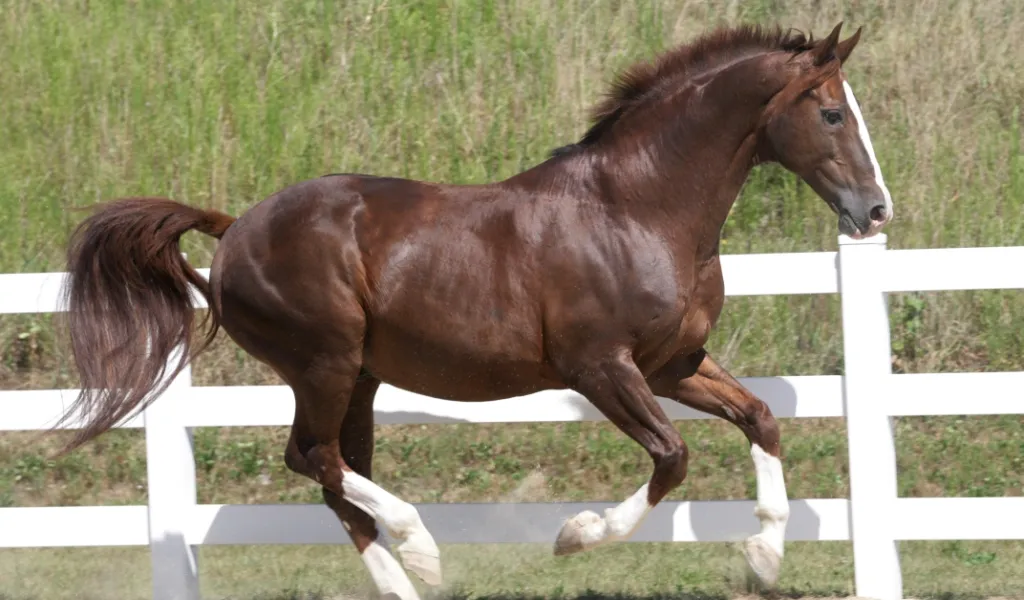The Oldenburg Horse is a horse breed that originated in Germany.
They are known for their beautiful movement, and are often used in showjumping and dressage.
The Oldenburg is a horse breed that is known for its athleticism, temperament, and beauty.
If you are thinking about adding an Oldenburg horse to your stable, here is everything you need to know about this majestic breed.
Oldenburg Horse Breed Info
Here are some of the key things you need to know about the Oldenburg:
| Height (size) | 16.0 – 17.2 hands high |
| Colors | Most commonly black, brown or gray, but tobiano horses are also seen |
| Country of Origin | Germany |
| Common Uses | Dressage, jumping, driving, eventing |
Oldenburg Facts & Information (Breed Profile)
Oldenburg is a type of a German warmblood horse.
It is not a breed of its own, but rather a warmblood type from Germany named after the region it is from.
The breed was developed from a mare basis consisting of all-purpose farm and carriage horses, which are known as Alt-Oldenburgers today.
The modern Oldenburg is regulated by the Association of Oldenburger Horse Breeders, which enforces careful breeding stock selection to ensure that each generation is better than the previous.
The Warmblood breed known as the Oldenburg originated in the German regions of East Friesland and Oldenburg in the 17th century.
Count Johan XVI of Oldenburg was an avid horse breeder, and bred admirable battle horses which he gave as gifts to war heroes, rulers and noblemen.
Anton Günther, who succeeded Johan XVI, is generally acknowledged as the founder of the Oldenburg breed.
Not only did he continue to import stallions to Oldenburg from Naples, Spain, Poland, England, Tartary, and Barbary, but he also let his tenants and other ordinary people to use his stallions on their own mares.
It wasn’t long before the tall, beautiful Oldenburg horses were in high demand as carriage and riding horses all throughout Europe.
In 1820, a law was passed that only allowed Oldenburg breeding programs to use stallions that had been approved by the government.
Soon after, the Oldenburg studbook and two breeding organizations were established.
The breed continued to enjoy great popularity, and was even exported as far as the United States.
However, as automobiles became more popular than carriages, breeders had to adjust their methods in order to secure the Oldenburg’s continued existence.
Fortunately, the breed had always been adaptable in its core, and the transition to all-around athletic performance was not a difficult one.
To further develop the Oldenburg, a large amount of Thoroughbred blood was added, and the breed saw great success under saddle.
Since the 1970s, there has been a significant rise in the use of different sport horse-type bloodlines, such as Trakehner, Hanoverian, Holsteiner, Westphalian, Anglo-Norman, Selle Français, Dutch Warmblood, and Anglo-Arab.
This offers the Oldenburg outstanding hybrid vigor without sacrificing any of the breed’s famed consistency in performance, movement, and temperament.
The majority of Oldenburg horse breeding nowadays is tightly regulated by the Oldenburg Breeding Society and is in the hands of private owners.
The “O” and crown mark on the left hip is the best way to recognize a contemporary Oldenburg.
As interest in show jumping has skyrocketed, several horse breeding groups have recently been criticized for breeding horses that are too “hot”, which produces elite athletic jumpers, but at the expense of rideability.
Like other German Warmbloods, the Oldenburg is not recognized as a distinct breed, but rather as a type since they have an open stud book, and are still evolving.
If you’re interested in learning more about this fascinating breed, keep reading!
Alternative Names
“Oldenburger”
Temperament/Personality
Kind disposition, very willing
Physical Characteristics
The head is fine and noble, and the wither are prominent.
The shoulder is sloped.
The back is strong with a good topline.
They have big, wide hooves that can easily support their weight, and their legs are well-muscled with sturdy joints.
Their gaits are very forward, fluid, elastic and expressive, and the majority of them are great jumpers.
They are built uphill, have strong hindquarters, a long, strong neck and a deep chest, all of which are characteristics of a classic sport horse.
Despite their size, they are always quite compact even though their physical type may vary depending on the particular horse’s pedigree.
Colors
Most commonly black, brown or gray, but tobiano horses are also seen
Height (size)
16.0 – 17.2 hands high
Stallions
n/a
Mares
n/a
Weight
Around 1700 lbs (770 kg)
Blood Type
Warm
Common Uses
Dressage, jumping, driving, eventing
Health
n/a
Popular Traits
Excellent jumping ability
Feeding/Diet
n/a
Country of Origin
Germany
Ancestors
Frederiksborg, Turkish horses, Neapolitan horse, Andalusian horse, Barb, Friesian
